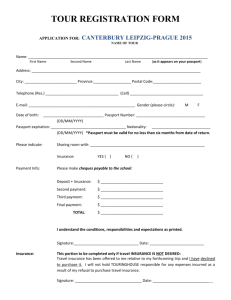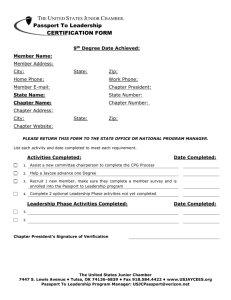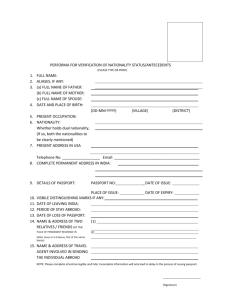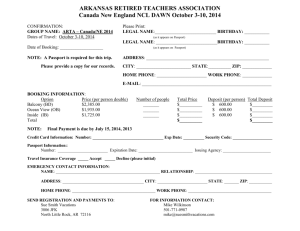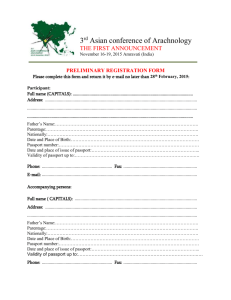est98455E
advertisement
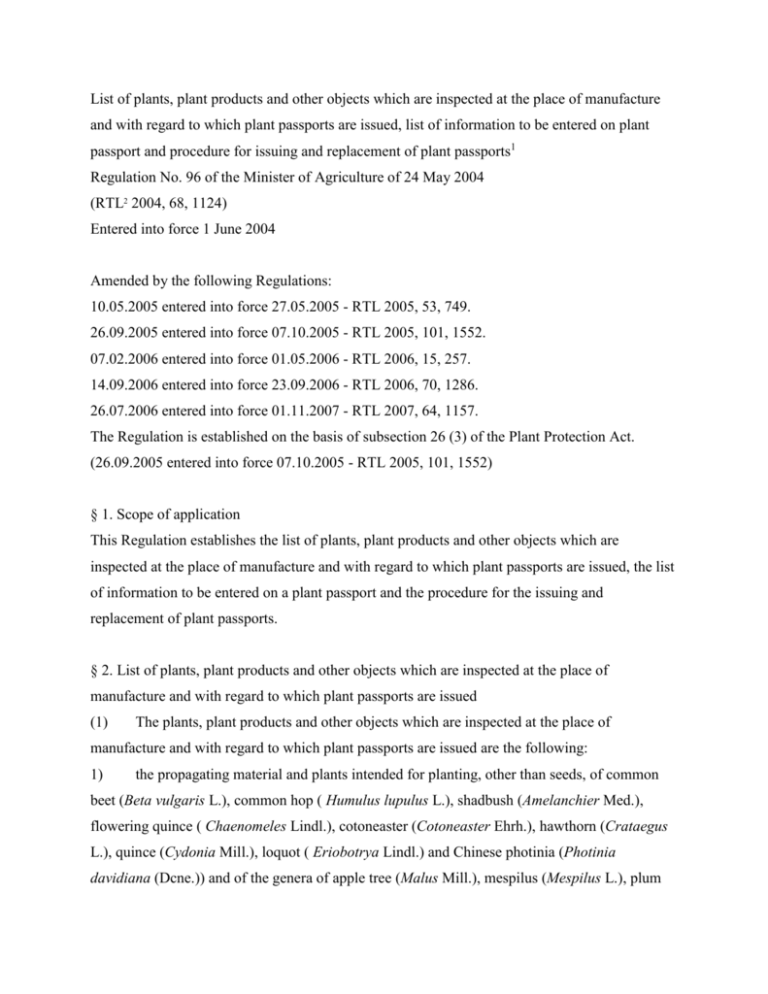
List of plants, plant products and other objects which are inspected at the place of manufacture and with regard to which plant passports are issued, list of information to be entered on plant passport and procedure for issuing and replacement of plant passports1 Regulation No. 96 of the Minister of Agriculture of 24 May 2004 (RTL2 2004, 68, 1124) Entered into force 1 June 2004 Amended by the following Regulations: 10.05.2005 entered into force 27.05.2005 - RTL 2005, 53, 749. 26.09.2005 entered into force 07.10.2005 - RTL 2005, 101, 1552. 07.02.2006 entered into force 01.05.2006 - RTL 2006, 15, 257. 14.09.2006 entered into force 23.09.2006 - RTL 2006, 70, 1286. 26.07.2006 entered into force 01.11.2007 - RTL 2007, 64, 1157. The Regulation is established on the basis of subsection 26 (3) of the Plant Protection Act. (26.09.2005 entered into force 07.10.2005 - RTL 2005, 101, 1552) § 1. Scope of application This Regulation establishes the list of plants, plant products and other objects which are inspected at the place of manufacture and with regard to which plant passports are issued, the list of information to be entered on a plant passport and the procedure for the issuing and replacement of plant passports. § 2. List of plants, plant products and other objects which are inspected at the place of manufacture and with regard to which plant passports are issued (1) The plants, plant products and other objects which are inspected at the place of manufacture and with regard to which plant passports are issued are the following: 1) the propagating material and plants intended for planting, other than seeds, of common beet (Beta vulgaris L.), common hop ( Humulus lupulus L.), shadbush (Amelanchier Med.), flowering quince ( Chaenomeles Lindl.), cotoneaster (Cotoneaster Ehrh.), hawthorn (Crataegus L.), quince (Cydonia Mill.), loquot ( Eriobotrya Lindl.) and Chinese photinia (Photinia davidiana (Dcne.)) and of the genera of apple tree (Malus Mill.), mespilus (Mespilus L.), plum tree (Prunus L.), except cherry laurel (Prunus laurocerasus L.) and Portugal laurel (Prunus lusitanica L.), firethorn ( Pyracantha Roem.), pear tree (Pyrus L.) and mountain ash (Sorbus L.); 2) plants, other than seeds and fruits, of the genera of rhododendron (Rhododendron spp.), except azalea (Rhododendron simsii Planch), and viburnum ( Viburnum spp.); 3) plants of the species forming stolons or tubers intended for planting and belonging to the genus of solanacea (Solanum L.) or hybrids thereof; 4) seed potatoes (Solanum tuberosum L.); 5) plants, other than seeds and fruits, of the genera of kumquat (Fortunella Swingle) and poncirus ( Poncirus Raf.) and the hybrids thereof, citrus (Citrus L.) and the hybrids thereof and grape (Vitis L.); 6) fruits with leaves and peduncles of the genera of citrus (Citrus L.), kumquat (Fortunella Swingle), poncirus (Poncirus Raf.) and the hybrids thereof; 7) wood which, has been obtained in whole or in part from the genera of sycamore ( Platanus L.), including wood which has not kept its natural round surface; 8) (Repealed - 10.05.2005 entered into force 27.05.2005 - RTL 2005, 53, 749) (2) The wood specified in clause (1) 7) shall be inspected at the place of manufacture and a plant passport shall be issued concerning the wood if it is: 1) fuel wood (in logs, in chunks, in billets, in twigs, or in similar forms); 2) wood in chips or particles; 3) wood waste not agglomerated in briquettes, pellets or similar forms; 4) wood stripped, non-stripped of bark or square-edged wood other than treated with paint, creosote or other protective agents, 5) chipped laths, piles, stakes and pickets of wood; 6) wood stripped, non-stripped of bark or square-edged wood including wood treated with paint, creosote or other protective agents; 7) wood sawn or chipped lengthwise not planed or treated otherwise, of a thickness exceeding 6 mm, including beams, planks, boards and laths. (3) The plants and plant products which are inspected at the place of manufacture and with regard to which plant passports are issued if they are marketed to a person whose main activity is further marketing thereof or production of agricultural produce, except for plants and plant products marketed to the final consumer, are the following: 1) the propagating material and plants intended for planting, other than seeds, of the genera of fir (Abies Mill.), aster ( Aster spp.), arctic daisy (Dendranthema (DC.) Des Moul.), pink (Dianthus L.) and hybrids thereof, strawberry ( Fragaria L.), dill daisy (Argyranthemum spp.), cabbage ( Brassica spp.), chestnut tree (Castanea Mill.), cucumber (Cucumis spp.), exacum (Exacum spp.), gerbera (Gerbera Cass.), baby’s breath( Gypsophila L.), all varieties of the New Guinean hybrids of touch-me-not (Impatiens L.), lettuce (Lactuca spp.), larch (Larix Mill.), daisy (Leucanthemum L.), lupin (Lupinus L.), geranium (Pelargonium l’Herit. ex Ait.), spruce ( Picea A. Dietr.), pine (Pinus L.), sycamore (Platanus L.), cottonwood (Populus L.), cherry laurel (Prunus laurocerasus L.), Portugal laurel (Prunus lusitanica L.), Douglas fir (Pseudotsuga Carr.), oak ( Quercus L.), raspberry (Rubus L.), spinach (Spinacia L.), tansy (Tanacetum L.), hemlock (Tsuga Carr.) and vervain (Verbena L.) and wild celery (Apium graveolens L.);; 2) the propagating material and plants intended for planting, other than seeds, flower bulbs, corms and other variants of stems, of the rest of the herb species, except graminaceous plants; 3) plants intended for planting, other than seeds of solanacea (Solanaceae) not specified in clause (1) 3); 4) rooted plants or plants otherwise connected with growing substrate from the families of arum (Araceae), arrowroot (Marantaceae), banana (Musaceae), strelitziaceae (Strelitziaceae) and from the genus of bay (Persea Mill.); 5) wild onion (Allium ascalonicum L.), garden onion ( Allium cepa L.) and wild chives (Allium schoenoprasum L.) seeds and bulbs intended for planting , and garden leek (Allium porrum L.) plants intended for planting; 6) bulbs and corms, intended for planting, of the genera and species of camas (Camassia Lindl.), chionodoxa (Chionodoxa Boiss.), yellow crocus (Crocus flavus Weston ‘Golden Yellow’), snowdrop (Galanthus L.), giant summer hyacint ( Galtonia candicans (Baker) Decne), miniature varieties and the hybrids thereof (peacock orchid ( Gladiolus callianthus Marais), Gladiolus colvillei Sweet., Gladiolus nanus hort., Gladiolus ramosus hort., Gladiolus tubergenii hort.), from the genus of gladiolus (Gladiolus Tourn. ex L.), hyacinth ( Hyacinthus L.), iiris (Iris L.), Ismene Herbert, narcissus ( Narcissus L.), star of Bethlehem ( Ornithogalum L.), puschkinia ( Puschkinia Adams), scilla (Scilla L.), peacock flower ( Tigridia Juss.) (Tulipa L.) and grape hyacinth ( Muscari Miller); (07.02.2006 entered into force 01.05.2006 - RTL 2006, 15, 257) 7) certified seeds of the species of alfalfa (Medicago sativa L.), common sunflower (Helianthus annuus L.), tomato ( Lycopersicon esculentum (Mill.) Karsten ex Farw.) and the genus of bean (Phaseolus L.); (07.02.2006 entered into force 01.05.2006 - RTL 2006, 15, 257) 7) certified seeds of the species of alfalfa (Medicago sativa L.), certified and standard seeds of the species of common sunflower (Helianthus annuus L.), tomato (Lycopersicon esculentum (Mill.)Karsten ex Farw.) and the genus of bean (Phaseolus L.).. (4) The plants, plant products and other objects which are inspected at the place of manufacture and with regard to which plant passports are issued if they are conveyed to or marketed in a protected zone are the following: (14.09.2006 entered into force 23.09.2006 - RTL 2006, 70, 1286) 1) plants of the genera of fir (Abies Mill.), larch (Larix Mill.), spruce (Picea A. Dietr.), pine (Pinus L.) and Douglas fir (Pseudotsuga Carr.); 2) plants intended for planting, other than seeds, of the genus of cottonwood (Populus L.) and common beet ( Beta vulgaris L.); 3) propagating material and plants intended for planting, other than seeds and fruits, of the genera of shadbush (Amelanchier Med.), flowering quince ( Chaenomeles Lindl.), cotoneaster (Cotoneaster Ehrh.), hawthorn ( Crataegus L.), quince (Cydonia Mill.), loquot (Eriobotrya Lindl.), eucalyptus (Eucalyptus l’Hérit.), apple tree (Malus Mill.), mespilus (Mespilus L.) pear tree (Pyrus L.), mountain ash (Sorbus L.), grape (Vitits L.) and firethorn (Pyracantha Roem.) and Chinese photinia (Photinia davidiana (Dcne.); (26.07.2006 entered into force 01.11.2007 - RTL 2007, 64, 1157) 4) pollen intended for pollination of the genera of shadbush (Amelanchier Med.), flowering quince (Chaenomeles Lindl.), cotoneaster (Cotoneaster Ehrh.), hawthorn (Crataegus L.), quince (Cydonia Mill.), loquot (Eriobotrya Lindl.), apple tree (Malus Mill.), mespilus (Mespilus L.), pear tree (Pyrus L.), mountain ash (Sorbus L.) and firethorn (Pyracantha Roem.) and Chinese photinia ( Photinia davidiana (Dcne.)), firethorn (Pyracantha Roem.); 5) seed potatoes (Solanum tuberosum L.); 6) plants intended for industrial processing of common beet ( Beta vulgaris L.); 7) soil and unsterilised waste from beet (Beta vulgaris L.); 8) seeds of common beet (Beta vulgaris L.), red bean (Dolichos Jacq.), cotton (Gossypium spp.) and kidney bean (Phaseolus vulgaris L.); 9) fruits (cores) of the genus of cotton (Gossypium spp.) and unginned cotton and fruits of the genus of grape ( Vitis L.); 10) wood, other than wood without bark, which, has been obtained in whole or in part from the order of Coniferales and the genus of chestnut tree ( Castanea Mill.); 11) isolated bark of the order of Coniferales and the genus of chestnut tree ( Castanea Mill.). (5) The wood specified in clause (4) 10) shall be inspected at the place of manufacture and a plant passport shall be issued concerning the wood if it is: 1) fuel wood (in logs, in chunks, in billets, in twigs, or in similar forms); 2) wood in chips or particles; 3) wood waste not agglomerated in briquettes, pellets or similar forms; 4) wood stripped, non-stripped of bark or square-edged wood other than treated with paint, creosote or other protective agents, 5) chipped laths, piles, stakes and pickets of wood; 6) railway sleepers of unimpregnated wood; 7) wood sawn or chipped lengthwise not planed or treated otherwise, of a thickness exceeding 6 mm, including beams, planks, boards and laths; 8) packing cases, wooden packings or drums; 9) goods pallets, box pallets or other wooden pallets, other than the goods pallets and box pallets complying with the standard provided for UIC pallets and labelled in accordingly; 10) wood stripped, non-stripped of bark or square-edged wood including wood treated with paint, creosote or other protective agents. (6) The plants, plant products and other objects which are inspected at the place of manufacture and with regard to which plant passports are issued if they are conveyed to a protected zone and marketed to a person whose main activity is further growing thereof, except the plants and plant products marketed to the final consumer, are the following 1) plants intended for planting, other than tubers, tuberous roots and seeds, of the genus of begonia (Begonia L.); 2) plants intended for planting, other than seeds, of poinsettia ( Euphorbia pulcherrima Willd.) and the genera of fig (Ficus L.) and hibiscus (Hibiscus L.). (10.05.2005 entered into force 27.05.2005 - RTL 2005, 53, 749) § 3. List of information to be entered on plant passport (1) A plant passport may be a label of a plant, plant product or other object or a label of a plant, plant product or other object and the accompanying document issued concerning the consignment. (2) A plant passport shall set out: 1) the word combination ''EEC-plant passport''; 2) indication of state ''EE''; 3) the name of the supervisory authority ''Plant Production Inspectorate'' or its abbreviation ''PPI''; 4) the number of the register entry of the person in the plant health register; 5) the number or other identifying mark of the consignment ; 6) the botanical name of the plant or plant product in Latin; 7) the quantity of the goods; 8) the marking ''ZP'' (zona protecta) if he plants, plant products or other objects are conveyed to a protected zone or marketed in a protected zone and the mark of identification of the protected zone; 9) the marking ''RP'' (replacement passport) in case of replacement of a plant passport. If a person replaces a plant passport issued by another person entitled to issue plant passports, the number of the plant health register entry of the person whose plant passport is replaced shall be indicated after the marking ''RP'' and if the replaced plant passport is issued in another Member State, the state indication shall be set out. If a person replaces a plant passport issued thereto by a supervisory official of the Plant Production Inspectorate concerning a consignment conveyed to Estonia from a third country, the phytosanitary certificate number shall be indicated after the marking ''RP''; 10) in the case of conveyance of plants, plant products and other objects from third countries to Estonia, the name of the country of origin or country indication and the phytosanitary certificate number. (3) If a plant passport consists of a label and an accompanying document, only the information specified in clauses (2) 1) – 5) needs to be set out on the label. (4) In the case of certified seed potato lots, certified seed lots of the species of alfalfa (Medicago sativa L.) and the certified and standard seed lots of the species of common sunflower (Helianthus annuus L.), (Helianthus annuus L.), tomato (Lycopersicon esculentum (Mill.) Karsten ex Farw.) and the genus of bean (Phaseolus L.) the information specified in clauses (2) 1), 4) and 8) – 10) shall be set out on the label. (5) In the case of lots of certified propagating material the information specified in clauses (2) 1), 2), 8) – 10) shall be set out on the plant passport and the label. A document of a supplier of other propagating material shall set out the information specified in clauses (2) 1), 8) – 10) and product specification shall set out all the information to be entered on the plant passport. (6) The text on a plant passport shall be clearly legible and indelible. The text on a plant passport shall be printed or written by hand. If information is written on a plant passport by hand, the text shall be presented in block letters. (7) A label which sets out the information of the plant passport shall be of waterproof material and non-reusable and be attached to a plant, plant product or other object, sales packaging or the to a vehicle carrying them in a manner which precludes reuse of the label. A plant passport prepared as a separate document (accompanying document) shall be added to the consignment. (14.09.2006 entered into force 23.09.2006 - RTL 2006, 70, 1286) § 4. Procedure for issuing and replacement of plant passports (1) The Plant Production Inspectorate shall issue a plant passport to a person who is entered in the plant health register on the basis of a written application thereof. (2) If the results of supervision reveal that the plants, plant products and other objects are declared to conform to the plant health requirements, the supervisory official shall issue a plant passport within three working days. (3) The Plant Production Inspectorate shall replace the plant passport of a person entered in the plant health register on the basis of a written application thereof and a copy of the plant passport within three working days. (4) If the reason for replacement of a plant passport is the changed condition of a consignment, a supervisory official of the Plant Production Inspectorate or a person entitled to issue plant passports may replace a plant passport only after the consignment has been checked and the supervisory official has declared the consignment to conform to the plant health requirements. § 41. Implementing Provisions (1) The seeds of the plants specified in clause 2 (3) 7), other than seeds marketed to the final consumer, shall be supplied with plant passports as of 1 September 2005. (2) Subsection 3 (7) enters into force 1 September 2005. (10.05.2005 entered into force 27.05.2005 - RTL 2005, 53, 749) § 5. Entry into force of Regulation This Regulation enters into force on 1 June 2004. ___________________________ 1 Council Directive 2000/29/EC on protective measures against the introduction into the Community of organisms harmful to plants or plant products and against their spread within the Community (OJ L 169, 10.07.2000, pp. 1–112), amended by Directives 2001/33/EC (OJ L 127, 09.05.2001, pp. 42–44), 2002/28/EC (OJ L 77, 20.03.2002, pp. 23–25), 2002/36/EC (OJ L 116, 03.05.2002, pp. 16–26), 2002/89/EC (OJ L 355, 30.12.2002, pp. 45–60), 2003/22/EC (OJ L 78, 25.03.2003, pp. 10–11), 2003/47/EC (OJ L 138, 05.06.2003, pp. 47–48), 2003/116/EC (OJ L 321, 06.12.2003, pp. 36–40), 2004/31/EC (OJ L 85, 23.03.2004, pp. 18–23), 2004/70/EC (OJ L 127, 29.04.2004, pp. 97–103), 2004/102/EC (OJ L 309, 06.10.2004, pp. 9–25), 2005/15/EC (OJ L 056, 02.03.2005, pp. 12–13), 2005/16/EC (OJ L 057, 03.03.2005, pp. 19–22), 2005/77/EC (OJ L 296, 12.11.2005, pp. 17) 2006/14/EC (OJ L 34, 07.02.2006, pp. 24–25), 2006/35/EC (OJ L 88, 25.03.2006, pp. 9–12), 2007/41/EC (OJ L 1699, 29.06.2007, pp. 51-52) amended by Council Regulation 806/2003 (OJ L 122, 16.05.2003, pp. 1–35) and Regulation 2004/882/EC of the European Parliament and of the Council (OJ L 165, 30.04.2004, pp. 1–141); Commission Directive 92/105/EEC establishing a degree of standardization for plant passports to be used for the movement of certain plants, plant products or other objects within the Community, and establishing the detailed procedures related to the issuing of such plant passports and the conditions and detailed procedures for their replacement (OJ L 004, 8.01.1993, pp. 22–25), amended by Directive 2005/17/EC (OJ L 057, 03.03.2005, pp. 23–24). (26.07.2006 entered into force 01.11.2007 - RTL 2007, 64, 1157) 2 RTL = Riigi Teataja Lisa = Appendix to the State Gazette


